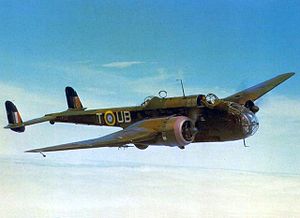Handley Page Hampden
| HP.52 Hampden | |
|---|---|
 |
|
| Hampden Mk.I of No. 455 Squadron RAAF (May 1942) | |
| Role | Medium bomber |
| Manufacturer | Handley Page |
| Designer | Gustav Lachmann |
| First flight | 21 June 1936 |
| Introduction | 1938 |
| Retired | 1943 |
| Primary users |
Royal Air Force Royal Canadian Air Force Soviet Naval Aviation Royal Australian Air Force |
| Produced | 1936–1941 |
| Number built | 1,430 |
|
|
|
|
|
The Handley Page HP.52 Hampden was a British twin-engine medium bomber of the Royal Air Force (RAF). It was one of a trio of then-large twin-engine bombers procured for the RAF, the other two being the Armstrong Whitworth Whitley and Vickers Wellington. The newest of the three medium bombers, the Hampden, was often referred to by aircrews as the "Flying Suitcase" because of its cramped crew conditions.
The Hampden served in the early stages of Second World War, bearing the brunt of the early bombing war over Europe, taking part in the first night raid on Berlin and the first 1,000-plane raid on Cologne. As the war went on, it became clear that the Hampden was unsuited to combat missions in the modern air war and, after a period of mainly operating at night, it was retired from RAF Bomber Command service in late 1942.
While the Hampden was powered by Bristol Pegasus radial engines, a short-lived variant known as the Handley Page Hereford instead featured in-line Napier Daggers.
In 1932, the Air Ministry issued Specification B.9/32 seeking a twin-engined day bomber as higher performance than any preceding bomber aircraft. Accordingly, Handley Page responded with their design to meet the requirements of B.9/32; this same specification also drew other submissions from rival aircraft manufacturer such as Vickers, who would proceed to develop the Wellington bomber to it. The design team, led by G.R. Vokert, drafted an extremely radical aircraft, initially centering upon the politically-favoured Rolls-Royce Goshawk engine; however, by mid-1934, development of the Goshawk looked less promising and thus the Air Ministry acted to relax the tare weight requirement of the specification, allowing for the use of heavier and more powerful radial engines such as the Bristol Perseus and Bristol Pegasus. According to aviation author Philip J.R. Moyes, the Handley Page design soon found support with the Air Ministry in part due to it was judged to represent a fair compromise between range, payload, and speed.
...
Wikipedia
